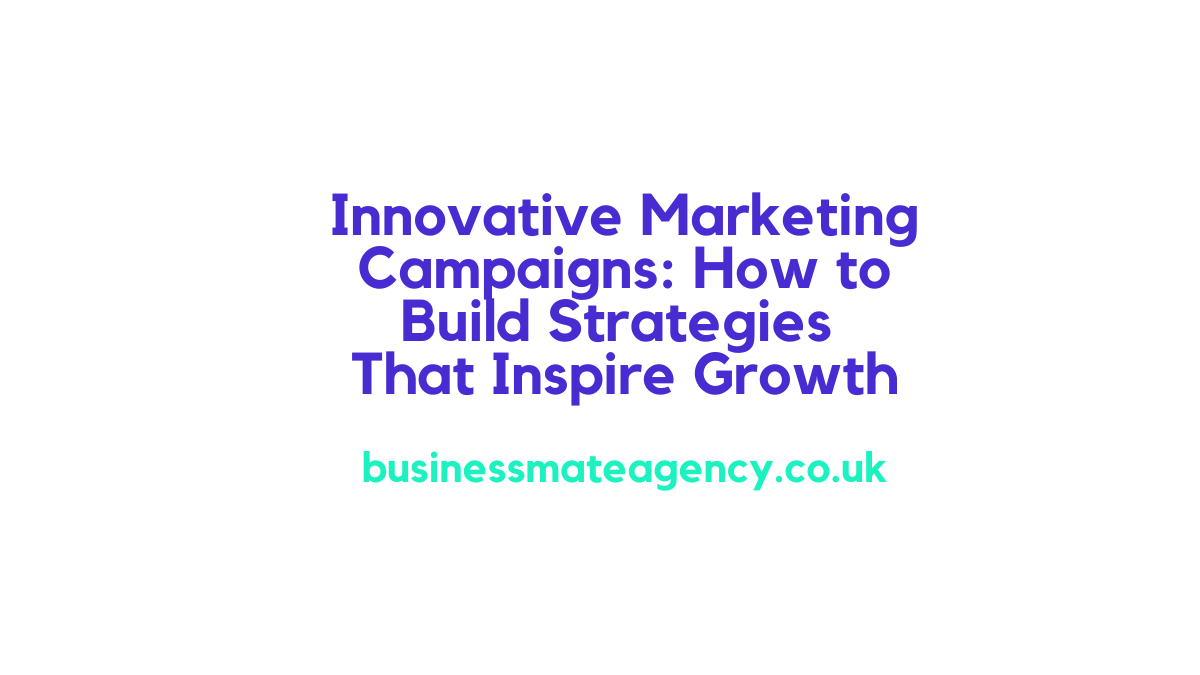Standing out online is hard. Audiences are busy, competitors are bold, and budgets must prove ROI. This is why innovative marketing campaigns matter. When you combine sharp strategy, strong creativity, and smart technology, you get work that people notice—and actions that your balance sheet notices too.
Whether you are a sole trader in Manchester, a growth-stage tech firm in Birmingham, or a national brand in London, the principles of campaign innovation stay the same: be relevant, be memorable, and be measurable.
Contact Us.
What Makes Innovative Marketing Campaigns Work
Great ideas are not enough on their own. The best campaigns blend five ingredients that turn creativity into commercial impact.
1) Audience-first insight
Start with the customer’s job-to-be-done. Map pains, triggers, and objections across the UK buyer journey. Then, build messaging that answers real questions—fast.
2) Data-driven decisions
Use analytics to size demand, refine targeting, and prioritise channels. Moreover, measure every step so creative choices stay linked to commercial outcomes.
3) Distinctive creative
Cut-through comes from clarity and surprise. Therefore, keep a simple core message and express it with a fresh visual hook, a memorable line, or an interactive moment.
4) Multi-channel orchestration
As attention fragments, integration wins. In addition to search and social, align email, landing pages, PR, and offline where relevant. Consistency compounds results.
5) Continuous optimisation
Ship, learn, improve. As a result, performance climbs while waste falls. Small weekly lifts often produce big quarterly gains.
UK Examples That Inspire
You do not need global budgets to apply global lessons. The following patterns scale up or down.
Local-first storytelling: Regional retailers using hyper-local social ads with community stories. The human detail boosts engagement and footfall.
Utility content that converts: B2B firms publishing short, “how-to” guides with calculator tools. These attract search traffic and warm leads.
Owned-data moments: Annual roundups (like “your year in stats”) packaged into shareable visuals. Participation drives viral reach at low cost.
Lightweight AR trials: Simple try-ons or product previews for mobile. Even modest interactions can lift time-on-page and purchase intent.
For compliance and credibility as you innovate, review ASA guidance: Advertising Standards Authority.
Contact Us.
A Simple Framework to Build Innovative Marketing Campaigns
Follow these six steps to go from idea to impact.
Step 1: Define the commercial goal
Tie the campaign to one metric: qualified leads, free trials, demo bookings, or store visits. Therefore, prioritise the KPI you can influence fastest.
Step 2: Choose the core audience and moment
Who needs you most this quarter? Which UK region, sector, or role? In addition, identify the trigger moments (renewals, tax year change, regulation shifts).
Step 3: Shape the message and creative hook
Write one-liners your audience would repeat. Then, craft a visual or interactive device that dramatises the value in three seconds or less.
Step 4: Select and connect channels
Pick two primary channels and one support channel. For instance, LinkedIn + Search backed by email nurture. Ensure tracking and UTM hygiene from day one.
Step 5: Launch a minimum viable campaign
Ship a clean version quickly. Moreover, limit variables so you can see cause and effect.
Step 6: Optimise weekly, report monthly
Adjust bids, audiences, and messages. As a result, you protect the budget while amplifying what works.
See our related blog “Marketing Ideas For Small Business To Grow On A Budget”.
Innovative Marketing Campaigns by Business Size
Sole traders and micro-businesses
Focus: one offer, one audience, one channel.
Tactics: short video reels, local search, quick landing page.
Tip: Reuse one strong story across three formats to save time.
SMEs
Focus: pipeline reliability.
Tactics: search + LinkedIn + email, supported by quarterly thought-leadership.
Tip: Map a 90-day nurture from first click to sales meeting.
Corporates
Focus: multi-market consistency and governance.
Tactics: modular creative system, country-level testing, central analytics.
Tip: Agree on shared definitions (MQL/SQL) to align marketing and sales.
Contact Us.
Creative Techniques That Lift Performance
Message mirroring: Use the audience’s own words from call notes and reviews. Therefore, relevance rises instantly.
Pattern breaks: Unexpected formats (polls, carousels, motion) interrupt scroll fatigue.
Value-first CTAs: Offer a template, checklist, or audit before asking for details.
Conversational landing pages: Short sections, proof early, and one primary action.
Proof stacking: Place a quick stat, a short quote, and a logo cluster above the fold.
See related blog “Facebook Advertising How To Create Campaigns That Convert“.
Innovative Marketing Campaigns Measurement That Keeps You Honest
Set up a lightweight measurement plan:
North-star KPI: e.g., qualified leads.
Two input metrics: cost per click, landing-page conversion rate.
One quality signal: sales acceptance rate or pipeline value.
Learning cadence: weekly review, monthly summary, quarterly reset.
In addition, keep a shared “kill or scale” log. As a result, teams act faster and avoid sunk-cost bias.
Innovative Marketing Campaigns Common Pitfalls (and Quick Fixes)
Too many goals: Pick one commercial outcome.
Crowded messaging: One idea per asset.
Over-segmentation early: Start broad; refine with data.
Skipping post-click: Fix page speed, clarity, and form friction.
No stop rules: Decide thresholds to pause or pivot.
The Future of Innovative Marketing Campaigns
AI will accelerate testing, creative variation, and prediction. However, human judgment still sets the brief, defines the idea, and ensures brand fit. Moreover, privacy changes will reward brands that own relationships and deliver genuine value. As a result, usefulness, trust, and distinctiveness will beat interruption.
Conclusion: Innovative Marketing Campaigns
Innovative marketing campaigns are not about spending more; they are about thinking better. With audience insight, disciplined measurement, and bold creativity, UK businesses of any size can run campaigns that stand out and pay back.
While we are a small agency and cannot match the world-class levels of the above agencies and budgets, we can certainly look into simpler options to launch your idea.
Contact us for more details.
FAQs – Innovative Marketing Campaigns
1. What is an innovative marketing campaign?
An innovative marketing campaign combines audience insight, data, creative ideas, and technology to produce results that stand out and deliver measurable ROI. Instead of relying on generic tactics, it uses fresh messaging, multi-channel orchestration, and continuous optimisation to gain attention and convert more customers.
2. How can small UK businesses create innovative campaigns on a budget?
Small businesses can innovate by focusing on one audience, one offer, and one primary channel. Formats like short video reels, local search optimisation, and simple landing pages provide low-cost ways to test ideas quickly. Repurposing strong stories across multiple formats maximises impact without increasing spend.
3. What makes a marketing campaign stand out in the UK market?
Standout campaigns are relevant, memorable, and measurable. They use customer language, clear positioning, distinctive visuals, and data-backed decisions. UK audiences respond strongly to localised storytelling, utility content, and value-first CTAs that help them solve problems before asking for details.
4. How do I measure whether my marketing campaign is working?
Effective measurement starts with a single commercial goal—such as qualified leads or demo bookings. Track two input metrics (like CPC and landing-page conversion rate) and one quality signal (such as sales acceptance rate). Review performance weekly, summarise monthly, and reset quarterly to stay honest.
5. How can AI improve innovative marketing campaigns?
AI speeds up testing, audience targeting, creative variation, and forecasting. It helps identify winning messages faster and reduces wasted spend. However, human insight remains essential for setting the brief, ensuring brand alignment, and guiding final creative decisions. The strongest campaigns blend AI efficiency with human strategy.



